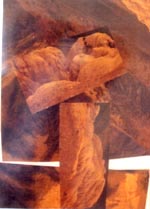An Experiment With Collage

An Experiment With Collage is an event that took place on 09-Feb-2001 in Hyderabad.
-
Venue
-
Date/Time
-
Type
-
Price
-
Add New Field:
REVIEW FOR AN EXPERIMENT WITH COLLAGE
"An unrecognized genius, he invests his turns and twists with immense power and plasticity. He is one of those exceptionally imaginative artists who deserve much greater exposure than they have had so far," wrote A S Raman about Aekka Yadagiri Rao, during the exhibition of 25 years of art in Andhra Pradesh in 1980.
With the montage of "Beatific Visions" Aekka has, to some extent, proved Raman's appreciation and foresight. Basically a sculptor, Aekka has experimented with scrappy, papery collages, taking a break from heavy sculpture that he normally works upon. After exhibiting extensively at national and international exhibitions and winning several honors and awards for his penchant medium - sculpture - he now displays a zest that can be taken seriously.
Says he: "My style of sculpture is very taxing. Therefore, I wondered what would be like to initiate myself in a new medium and gauge my abilities of experimenting - a freshness for myself."
Although the medium of collage is as old as Picasso himself, it has offered innumerable possibilities to the younger generation of artists. Its offshoot, the 'Mixed Media', a postmodern phenomenon, has rudely agitated the conventional modes of painting and sculpture. Therefore, collage can be considered to be at the core of the new shift in many artistic working methods.
Coming back to Rao, one has to definitely appreciate the challenge this 62-year-old artist voluntarily takes upon himself. But besides this, there's a lot in "Beatific Visions" that not only escapes the viewer, but also seems to leave a gap in the artist's perception.
First of all, the montage seems to lack any kind of character. A want of purpose gapes back at you. Especially considering that collages are modes of applied art, meant to accelerate commerce and communication, the artist with his display has been able neither to break the set tradition nor to utilize it as Picasso could.
The only aspect where the artist seems to try out here is the textural effect. And that too, we find only in a couple of frames. Otherwise the entire montage appears to be an unsatiated self-indulgence, which should have been given more time to mature. In some frames, the use of glossy cutouts grossly deviates and defeats any kind of concept. But only if there was any.
I could only interpret a confused display. Satiated by the evolving results, he offers us an amalgamation of tone and glossy images to interpret. On offer is an assembled jargon; plenty to look at but little to chew upon. Concept may be defeated by 'passion', but the desire to search is lucid. Discounting his desperation to be identified in a new medium and his anxiety to find a foothold in the contemporary chaotic plastic world, one should take Rao's efforts as a humanistic experience.
AA
USER REVIEWS FOR AN EXPERIMENT WITH COLLAGE
Be the first to comment on An Experiment With Collage! Just use the simple form below.
LEAVE A COMMENT
fullhyd.com has 700,000+ monthly visits. Tell Hyderabad what you feel about An Experiment With Collage!
MORE EVENTS IN THIS PERIOD
ALL EVENT CATEGORIES
SEARCH EVENTS
Dissatisfied with the results? Report a problem or error, or add a listing.
ADVERTISEMENT
SHOUTBOX!
{{ todo.summary }}... expand »
{{ todo.text }}
« collapse
First | Prev |
1 2 3
{{current_page-1}} {{current_page}} {{current_page+1}}
{{last_page-2}} {{last_page-1}} {{last_page}}
| Next | Last
{{todos[0].name}}
{{todos[0].text}}
ADVERTISEMENT
This page was tagged for
Lakshana Art Gallery events
February 2001 events
hyderabad arts
hyderabad paintings
hyderabad exhibitions